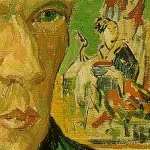
Near the end of the walkway that leads to the visitor's entrance to St. Paul's Hospital in Saint-Remy one finds a bronze statue of Vincent Van Gogh. In his left hand he holds a bouquet of gargantuan, oversized sunflowers; his right hand hangs limp and emptily at his side. His face, meanwhile, is fixed with a far off expression, the look of a man too involved with extraworldly concerns to survive in this unforgiving valley of tears. It's an artfully constructed, and I'm sure for most people affecting, statue, but when I look at it I can only think "Ughh." I griped last time about cliched ideas regarding artists and madness, specifically the idea that Vincent Van Gogh was mad and for that reason--rather than in spite of it--he became a great artist. But there's another, almost equally strong, myth about Van Gogh, one that I see motivating the statue at St. Paul's: the myth of the Artistic Saint. The opposite of the myth of the Mad Artist, this myth insist on seeing Van Gogh as a symbol of almost inhuman purity. Keepers of the myth see him as fundamentally a victim: of his times, of artistic conventions, of poverty, of illness, of anonymity. He was a beautiful soul tortured by ideals too high for this world, creating in the midst of his sufferings those sweet, bright paintings for which he is best known. Listen to Don McLean's cloying "Vincent" (you probably know the song as "Starry Starry Night") to hear the perfect expression of this myth. Like a saint tortured for his belief, Van Gogh suffered for his idealism; and like a saint rewarded for his trials by entering heaven in the afterlife, Van Gogh has gone on to his own eternal reward: artistic immortality.
Yuck.
The Artistic Saint may be an even more aggravating myth than Vincent the Madman, perhaps because it is as impicitly condescending while at the same time pretending sympathy. No doubt Vincent Van Gogh suffered. The path he finally chose for his life--after an extended period of false starts--was not an easy one. But here's the deal: He did choose it. He knew what he was getting into. Anyone who has read Van Gogh's letters knows what a shrewd (in the best sense) and canny man he was. He wanted pity from no one, especially not from his family. In his mind, nothing he did, and none of the physical and emotional trials he went through, deserved pity. They were simply what one could expect when one devotes oneself completely to one's craft. All he ever really wanted from others was the recognition that he knew what he was doing. Which he self-evidently did. Neither was Van Gogh a saint of any kind. He could be short tempered, self-involved, and petty, even toward his brother, whose monthly contributions he literally could not have survived without, and certainly toward his parents. In fact, as I drafted my novel I felt a growing sympathy for Van Gogh's father, who Vincent often potrtayed in letters as a dunderhead and tyrant of respectability. The fact is, Vincent Van Gogh was not an easy person to deal with, even if one loved him and was trying to help him. His whole life he demonstrated an innate fury--he was an Aries, for anyone who cares about such things--that drove him both to extremes and to discoveries. Not until late in his life, physically exhausted and morally depressed by the epileptic attacks that came at regular intervals and clearly would keep coming, did the tone of his correspondence become more despondent and that fury dampen. In their 1955 book Passionate Pilgrim, one of many I've consulted in my research, Lawrence and Elisabeth Hanson argue that it wasn't until he was confined in St. Paul's that Van Gogh, his rough edges worn away by illness and defeat, showed the sympathetic personality so commonly associated with him. Now, Passionate Pilgrim is a deeply flawed book, with some grotesque factual errors and an unfortunate carping tone, as the authors go out of their way to say more or less one thing: Vincent Van Gogh was not a pleasant man. Personally, I think the Hansons oversell their case; they overlook a great deal of evidence that suggests Van Gogh was a loyal friend, a cheerful correspondent, an intelligent and determined craftsman, a remarkably astute reader of the contemporary art scene, and--it must be said--a real sap when it came to women he was infatuated with. But they are right about this: Van Gogh was not a saint. If he were, he would not be such an engaging character to fictionalize--and that he surely is proving to be.













0 comments:
Post a Comment